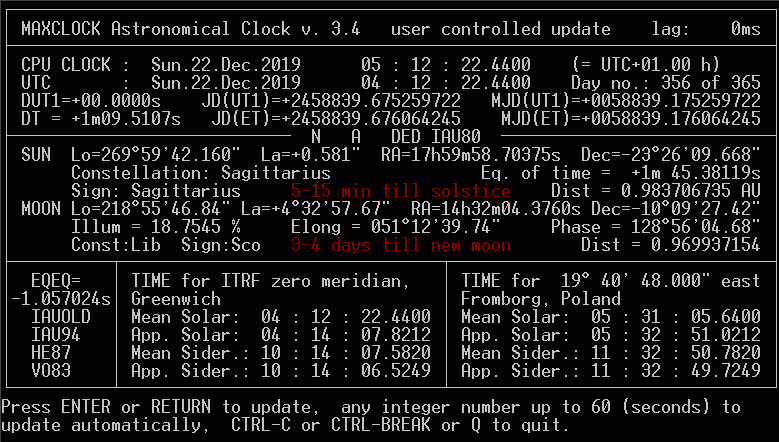The UMARK website
MAXCLOCK 3.4
Software Description
MAXCLOCK is a high-precision digital astronomical clock. It displays the following data
on your computer screen:
-
Civil date & time, day number in the year;
-
Julian date and modified Julian date both in terms of ephemeris time ET (TT) and
universal time UT1;
-
Delta-T, the difference between ET and UT1;
-
Mean solar time, apparent solar time, equation of time;
-
Mean sidereal time, apparent sidereal time, equation of equinoxes;
-
Geocentric ecliptical and equatorial coordinates of Sun and Moon;
-
Constellation and zodiac sign for the Sun;
-
Constellation, zodiac sign, phase, appearance, and illuminated fraction of the Moon;
-
Elongation between Sun and Moon;
-
Earth distance to Sun and Moon;
Coordinates may be referenced to mean dynamic equinox and ecliptic of date or to FK5. The inclusion of nutation and/or aberration is freely selectable.
Time data are displayed for ITRF Greenwich zero meridian. Solar and sidereal times are also displayed for any other freely user-selectable location anywhere on planet earth, e.g. for your home
observation site.
Other features:
-
The program uses the internal clock of the computer and an easy-to-edit configuration file only.
-
The screen display has manual and automatic mode, update interval in automatic mode may be selected
between one and 60 seconds.
-
Timely announcements are issued when Moon phases, solstices, or equinoxes are nearing.
-
Nutation and precession are modelled with conventional paradigm using IAU 1980 lunisolar
series. Various options for equation of equinoxes are available:
classical or IAU equation, with or without Herring's and Vondrak's corrections.
-
Two obliquity polynomials are selectable.
-
Enables computations for freely user-supplied date & time (typed through keyboard or read from file, with appropriate internal evaluation of ephemeris time). Julian and Gregorian calendar are implemented, covering a total timespan from 9999 BC to AD 9999. Thus, compilation of time-lapse-sequences is possible.
-
The internal ephemeris time model uses latest results from F.R. Stephenson, L.V. Morrison, J. Chapront, M. Chapront-Touzé and G. Francou. It is adjusted for most actual tidal acceleration
and incorporates high-precision Delta-T values (derived from IERS C04 data) up to date of issue.
The model may be modified by user-supplied Delta-T values.
-
DUT1 is freely selectable by user.
-
The output may also be directed to a protocol file.
-
Acoustic time signalling (time beeps) can be selected.
-
The package comes with detailed user instructions, as well as information about algorithms,
accuracy, and literature references.
Overall accuracy (near epoch 2000):
Position of Sun:
0.006 arcsecs (full VSOP87 algorithm)
Distance to Sun:
3.0x10-8 AU
Position of Moon:
0.05 arcsecs (truncated ELP2000-82B-algorithm)
Distance to Moon:
3.0x10-8 of nominal distance
Mean time values:
determined only by user-supplied geographic longitude accuracy
Apparent sidereal time:
microsecond domain (planetary perturbations)
Apparent solar time and equation of time:
millisecond domain (due to positional accuracy of Sun)
Availability:
MAXCLOCK will run on any PC / XT / AT (x86, x88, x286, x386, x486, Pentium, with or without math
coprocessor), under any DOS or WINDOWS operating system.
A textmode-only black & white screen and 390 kB RAM (800 kB RAM under WINDOWS VISTA / WINDOWS 7 / WINDOWS 8 / WINDOWS 10 / WINDOWS 11) will suffice.
(For automatic clock mode, a working system clock and a x286 processor, preferably
with coprocessor, is required at minimum.)
Distribution:
MAXCLOCK is distributed for free, either per e-mail directly by the author (including tailored configuration file) or per
download from the webpage.
Author & Copyright:
Udo Mark
E-Mail: 
Screenshot example:

© 2025 Udo Mark
www.umark.de/maxclock_descr_e.html last revised: 2025-08-30
